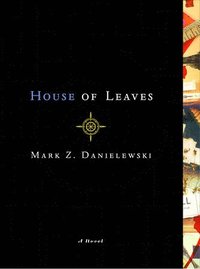
Johnny Truant is looking for a new apartment when his friend Lude tells him about an apartment in his building that had belonged to a man called Zampanò who had recently died. In the left-over belongings after Zampanò, Truant finds that he had compiled a manuscript, an academic study, about a film documentary called The Navidson Record. This documentary tells the story of Will Navidson, a Pulitzer Prize winning photojournalist, who, together with his family, moves into an old house in Virginia. This house turns out to intermittently be significantly larger on the inside than on the outside, and the documentary details the horrific attempts to explore the vast dark interior of the building. However, Truant also finds out that a significant number of the numerous references (it is an academic work after all) in the Zampanò manuscript does not exist, and that Zampanò was blind. Truant goes through the text and adds details to the footnotes, while at the same time his own life falls apart and his sanity seems to evaporate.
There are many layers present in House of Leaves by Mark Z Danielewski. The Navidson Record functions as the skeleton from which both the story about Navidson’s exploration of the house and Zampanò’s interpretations are told, and the story about Johnny Truant is uncovered through the extensive footnotes in the reworked manuscript. Quite a lot of the context in the book also comes through the sometimes unusual typographical setup in the text, where narrow hallways lead to narrow pages and the sometimes maze-like corridors and endless spiral stair-cases lead to a confusing set of chained interconnected footnotes combined with text going in all directions at once. In fact, I had the feeling that the form was more important than the content in the book. House of Leaves is a voluminous book, but there is not a lot of story told within it. A lot of the background is only hinted at, which opens up for interpretations, but what is actually told in the text is not much. There are also many things cleverly, or sometimes not so cleverly, hidden in the book to initiate discussions. Just to give an obvious example I can mention that the front cover of the book is exactly 1/2” narrower than the book block, to be compared with the 1/4” initial discrepancy in the house as noticed by Navidson.
It seems as if many people think it is important to put books into genres. In this case that is not so easy. The film in the book is clearly of the horror and adventure variety, exploring a dark and cold unknown that should not even be able to exist. However, Zampanò’s manuscript is an academic text, and it interprets the background of the film as a description of how the love between Navidson and his wife develops over time. Furthermore, the story about Johnny Truant is again a horror story, but in the psychological sense, about the obsession to dig deeper and deeper to find the possible truth. Finally, House of Leaves itself could easily be interpreted as a satire of serious text and film analyses like the ones you find in magazines for cineasts.
It is a good read, but it is also a time-consuming read. It feels ambitious, but it also feels a bit bloated, and sometimes with a lot more style than substance. I enjoyed the playfulness and the way Danielewski breaks and subverts the standard rules of the format: The book has a big index where we can see where every instance of the word “so”, for instance, is located in the text. Anyway, I like the book, but I do not consider it to be a great one.
Make no mistake, those who write long books have nothing to say. Of course those who write short books have even less to say.